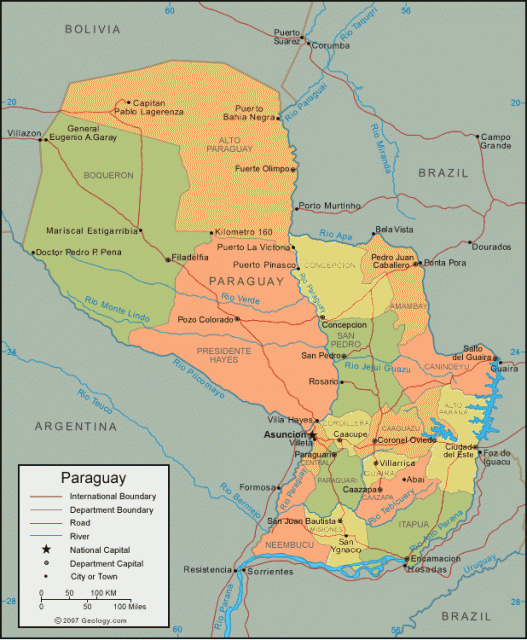Paraguay
Area 157,047 square mi (406,750 square km)
Population 6.553 million 2014
Capital Asuncion
Highest Point 2,762 ft (842 m)
Lowest Point 151 ft (46 m)
GDP $30.98 billion 2014
Primary Natural Resources cotton, sugarcane, soybeans.
THE REPUBLIC OF PARAGUAY is a LANDLOCKED country located in the central region of South America bordered by BOLIVIA, ARGENTINA, and BRAZIL and is slightly smaller than the state of CALIFORNIA. Paraguay is divided by the Rio (River) Paraguay into the eastern Paranena region and the western Chaco region. In the Paranena region, lands range from low plains to mountains, with the highest elevations occurring near the border with Brazil.
The Chaco region consists of a vast low-lying plain that makes up more than 60 percent of Paraguay’s territory. Near the Rio Paraguay, the plains are quite marshy, while at the interior, they are dry and often parched from drought. As a result of being landlocked, Paraguay depends upon the navigable Rio Paraguay for most of its trade, which flows through to BUENOS AIRES, Argentina. Paraguayan foreign policy is mostly dominated by Argentine decisions.

The climate is tropical and subtropical but becomes more temperate toward the south of the southern portions of the country. The Paranena region is notably humid and has abundant rainfall, which is distributed in relatively equal amounts throughout the year. In contrast, the Chaco region has a clearly distinguishable wet and dry season. The lack of efficient drainage renders the Chaco region susceptible to flooding. Temperature variations are modest, ranging between hot and humid to mild and damp.
Paraguay’s population is mostly concentrated in the southern part of the country. The government is based at the capital of Asuncion, which has a special government status, and the remainder of the country is separated and administered into 17 departments. The country is governed by a strong executive who shares authority with a bicameral legislative branch and a supreme court, all of which was established by the most recent national constitution, signed on June 20, 1992.
HISTORY
The acceptance of the constitution marked a return to democratic government, following 35 years of military dictatorship, led by Alfredo Stroessner. Paraguay’s history has almost always been marked by conflict, whether it is political infighting or border disputes.
The War of the Triple Alliance, which lasted from 1865 to 1870, proved disastrous for Paraguay, which lost much of its territory and more than two-thirds of its adult males as a result. Following the horrific costs of the war, Paraguay remained stagnant for well over a half-century, until it was able to invade some Bolivian lands and to retain them following the settlement of the Chaco War, which lasted from 1932 to 1935. Even after the conclusion of the major wars in which Paraguay participated, government instability still reigned, allowing Stroessner to seize power for over three decades.
Paraguay’s economy is market-based but dominated by a large informal sector, made up of thousands of microenterprises and street vendors. The majority of the population is able to survive as a result of their own family-level agricultural activity that generates enough for subsistence. Even though the formal economy has continued to grow at modest levels, most international observers blame political corruption, uncertainty about reform, and substantial debt for the lack of a stronger and more positive growth.